When we think of apple trees, one name that often comes to mind is Johnny Appleseed. This legendary nurseryman traveled throughout the Midwest planting apple trees and sharing his love of nature with others. Today, many people are inspired by his legacy and want to grow their own apple trees from seed. While it may seem daunting, growing an apple tree from seed can be a fun and enriching experience. It will allow you to connect with nature and appreciate the fruits of your labor. So, why not channel your inner Johnny Appleseed and start planting? Keep reading to learn how to grow an apple tree.
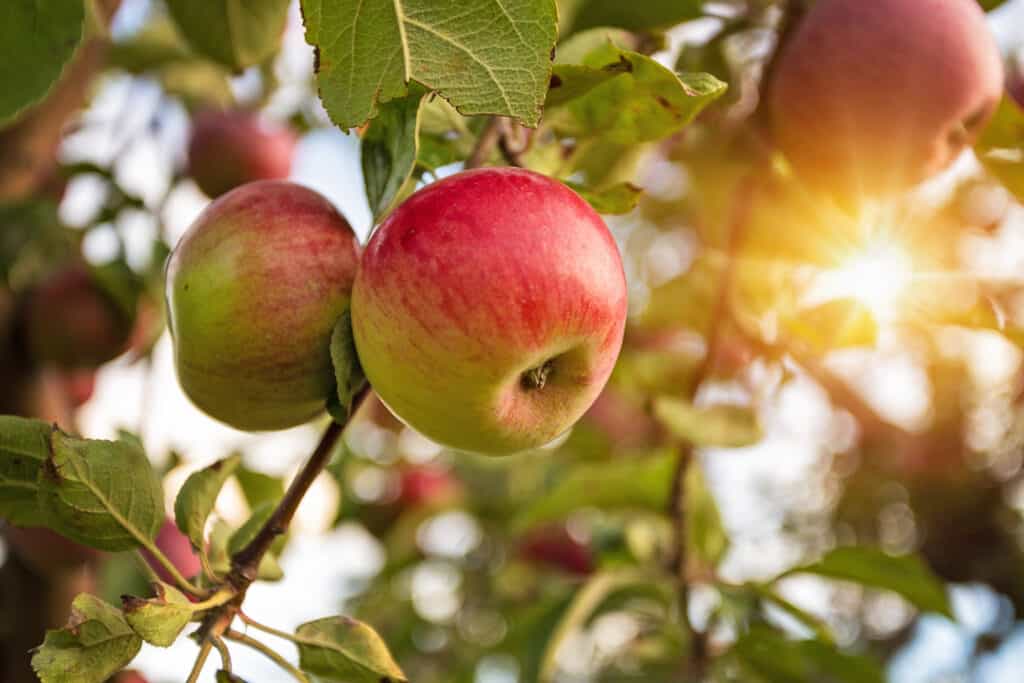
Johnny Appleseed was a legendary nurseryman who planted apple trees throughout the Midwest.
©Romiana Lee/Shutterstock.com
What is an Apple?
An apple (Malus domestica) is a type of fruit that grows on an apple tree, a deciduous tree in the rose (Rosaceae) family. Apples are round or oval-shaped, and come in a variety of colors, including green, yellow, and red. They are typically 2-4 inches (5-10 cm) in diameter and have a crisp, juicy flesh with a mildly sweet to tart flavor. Apples are a good source of fiber and vitamin C. They are also a popular ingredient in a wide range of culinary dishes, including pies, sauces, and juices. These fruits are also commonly eaten as a snack, either whole or sliced. They are often paired with other foods, such as cheese or peanut butter, to complement their flavor.
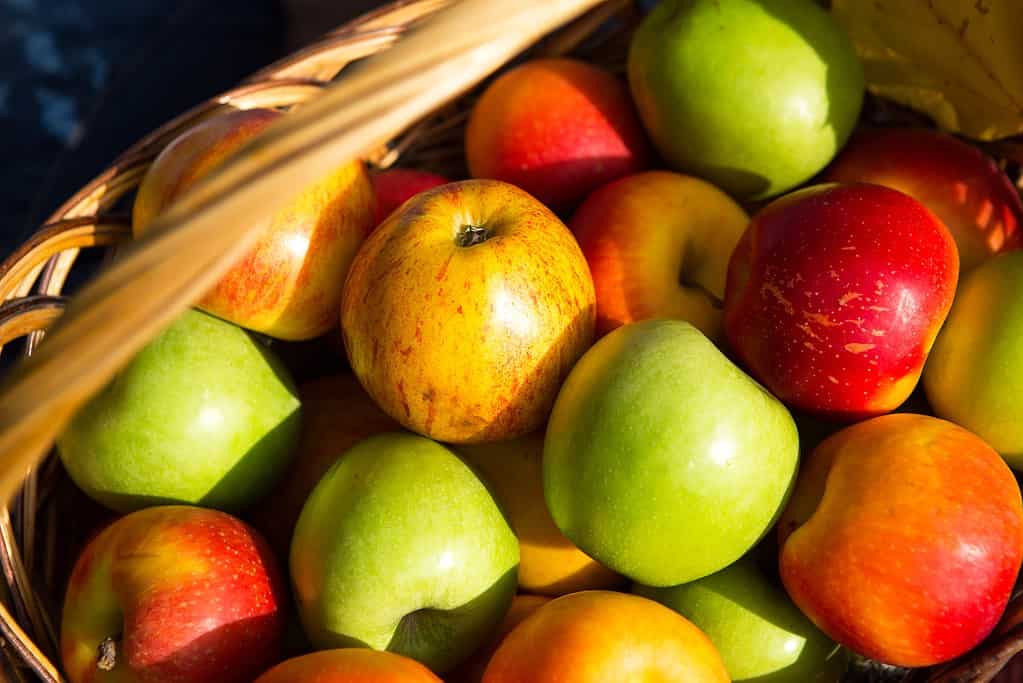
Apples are round or oval-shaped, and come in a variety of colors, including green, yellow, and red.
©Simol1407/Shutterstock.com
Selecting a Variety
There are thousands of varieties of apples. New ones are being developed all the time through selective breeding and genetic engineering. However, most of these varieties are not widely grown or available to consumers. In terms of commercially available varieties, hundreds of different types of apples can be found in grocery stores and farmers’ markets around the world. Some of the most common varieties include: Braeburn, Fuji, Gala, Golden Delicious/Red Delicious, Granny Smith, Honeycrisp, McIntosh, and Pink Lady.
Each variety of apple has its own flavor, texture, and color. Some are better suited for certain uses than others. For example, some apples are best eaten fresh, while others are better for baking or cooking.
The wide range of apple varieties available means that there is an apple out there for every occassion.
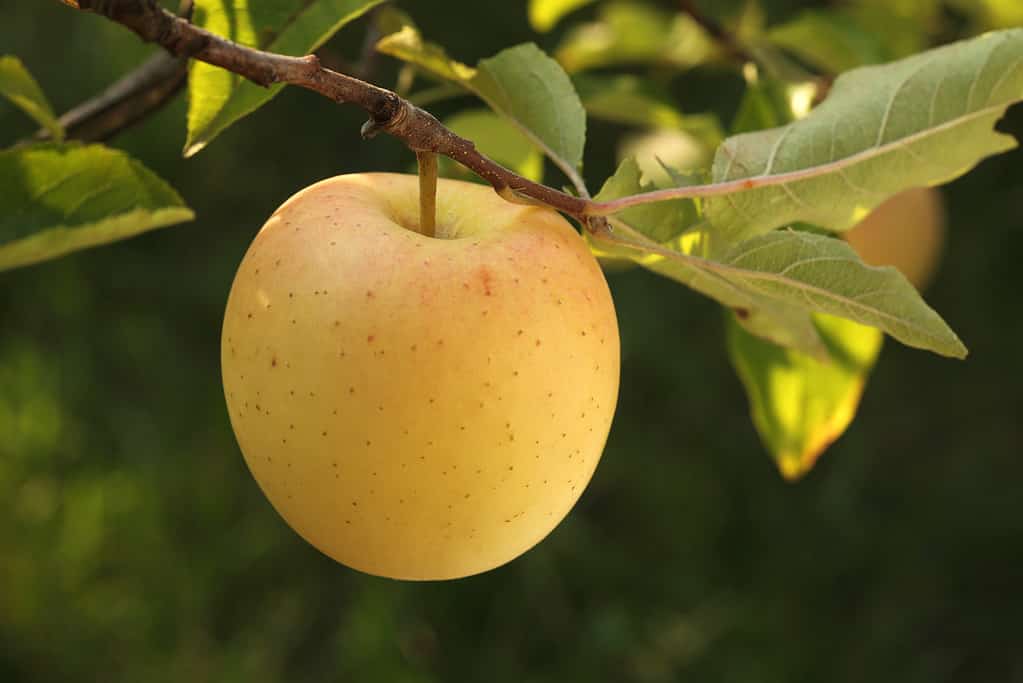
New varieties of apples are developed all the time through selective breeding and genetic engineering.
©Shulevskyy Volodymyr/Shutterstock.com
Apples for Beginners
While every apple tree variety requires some care and attention to grow successfully, some are easier to grow than others. Here are a few apple tree varieties that are known for being relatively easy to cultivate:
- Golden Delicious: This variety is a good choice for beginners. It is easy to care for and produces consistent sweet, juicy apples.
- Red Delicious: Red Delicious apples are sweet and flavorful and can be eaten fresh or used in cooking and baking.
- Jonathan: This variety produces tart, tangy apples that are great for baking and making applesauce. The trees are relatively easy to maintain.
- Rome: This variety is known for its firm texture and tart flavor, and it is a good choice for baking and cooking. The trees are also relatively easy to care for and can be grown in a variety of climates.
The ease of growing an apple tree will depend on a variety of factors. These include the climate and soil conditions, as well as your level of experience and knowledge about fruit tree care. But with a little patience and effort, anyone can learn to grow their own delicious apples at home.

Red delicious apples are sweet and flavorful and can be eaten fresh or used in cooking and baking.
©Serhii Hrebeniuk/Shutterstock.com
Requirements
Growing a healthy apple tree requires the right combination of temperature, light, soil pH, and water, and space.
Temperature and Sunlight Requirements
Most apple tree varieties require a cold climate with a long growing season to thrive. They need a period of dormancy during the winter months, followed by warm temperatures in the spring and summer. These factors promote growth and fruit production. The optimal temperature range for apple trees is between 60- and 75-degrees Fahrenheit (15 to 24 C), which applies to a wide range of USDA Hardiness Zones. Generally speaking, apple trees grow best in zones 4-8, although some varieties can be grown in Zone 3 and Zone 9 as well. Some varieties are cold-hardy and can tolerate freezing temperatures, while others are heat-tolerant and can thrive in warmer climates.
Apple trees require full sun exposure to grow and produce fruit. They need at least six hours of direct sunlight per day, although more is better. Trees that are shaded or receive insufficient light may produce a smaller harvest.
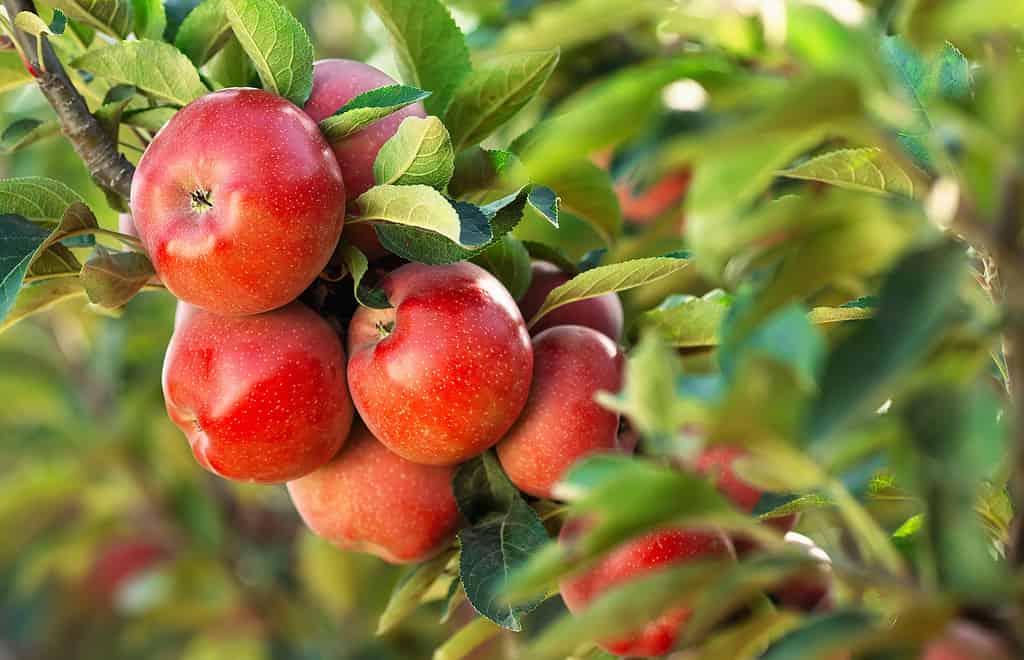
Most apple tree varieties require a cold climate with a long growing season to thrive.
©David Tadevosian/Shutterstock.com
Soil and Water Requirements
Apple trees prefer a slightly acidic soil between 6.0 and 6.5. They can tolerate a range of soil types but do best in well-draining soils that are rich in organic matter. It’s important to test the soil before planting and to make any necessary adjustments to the pH and nutrient levels. Soil meters and pH test kits are available at most garden centers. Apple trees need regular, consistent watering to stay healthy and produce fruit. They typically require about 1 to 2 inches (2.5 to 5 cm) of water per week.
In addition to these factors, proper fertilization and pruning are also important for maintaining health and productivity. With the right care and attention, a healthy apple tree can produce a bountiful harvest of delicious fruit for years.

Apple trees prefer a slightly acidic soil pH between 6.0 and 6.5.
©Tama2u/Shutterstock.com
Space and Pollination Requirements
The amount of space an apple tree requires depends on the variety and expected size of the mature tree. Apple trees should be spaced at least 10 to 15 feet (3-4.5 m) apart to allow for adequate sunlight and air circulation. However, dwarf or semi-dwarf apple trees can be planted closer together, with a recommended spacing of 6 to 10 feet between trees. Though some apple tree varieties are self-pollinating, most apple trees require cross-pollination with another compatible apple tree to produce fruit. This is because the apple tree’s flowers contain both male and female parts, but they can’t pollinate themselves. Instead, pollen from the male parts of one tree must be transferred to the female parts of another tree.
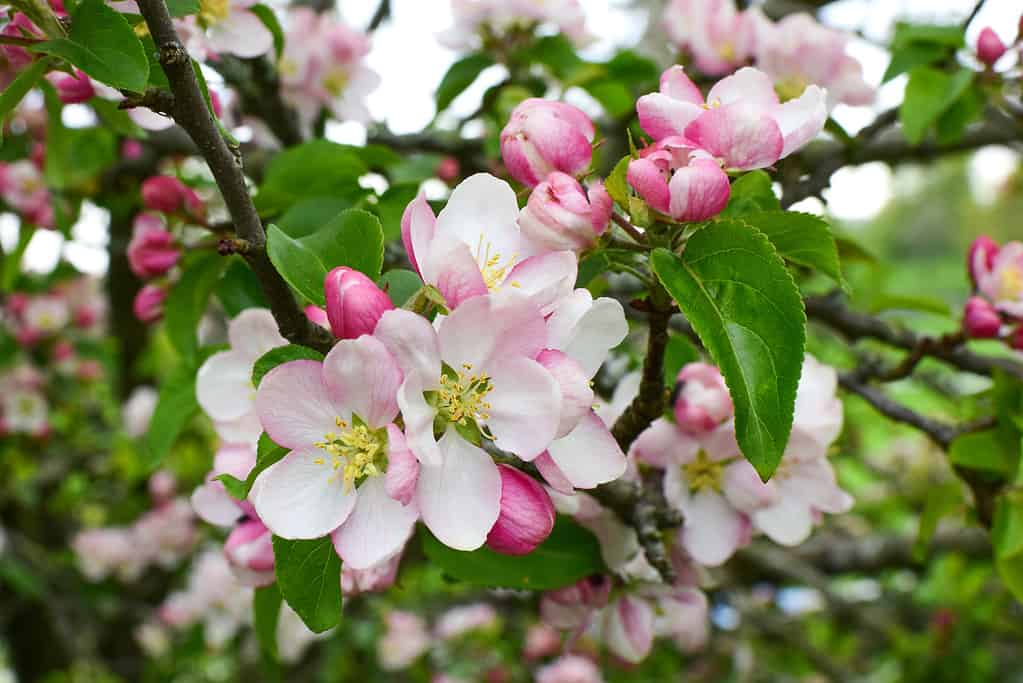
Generally speaking, apple trees require cross-pollination with another compatible apple tree to produce.
©AntiD/Shutterstock.com
Planting the Seed
Growing an apple tree from seed can be a gratifying experience, but it requires patience. It can take a long time before the tree produces fruit. In fact, it will take six to 10 years before the tree produces its first meaningful harvest. This is because apple trees grown from seed must go through a juvenile phase which can take several years. Apple trees grown from seed are usually not true to the parent. This means that the fruit produced may not be the same as the apple it was grown from. Regular pruning encourages fruit production.

If you start an apple tree from seed, it will take six to 10 years before the tree produces its first harvest.
©Valeriya Rychkova/Shutterstock.com
How to Grow an Apple Tree: Step-by-Step Guide
- Obtain apple seeds: To start growing an apple tree from a seed, you will need apple seeds. These can be collected from ripe apples or purchased from a reputable seed supplier.
- Prepare the seeds: To increase the chances of germination, you can stratify the seeds by placing them in a plastic bag with some damp peat moss or vermiculite and storing them in the refrigerator for six to eight weeks. This mimics the winter conditions that the seeds would experience in nature and can help break their dormancy.
- Choose a planting location: Apple trees require full sun and well-draining soil. Choose a location that receives at least six hours of sunlight per day and has soil that is deep, fertile, and loamy.
- Plant the seeds: Once the seeds have been stratified, they can be planted in the ground or in containers. If planting in the ground, dig a hole that is about 2-3 inches (5-7 cm) deep and place the seed in the hole. Cover the seed with soil and water thoroughly. If planting in a container, fill the container with potting soil and plant the seed about 1 inch (2.5 cm) deep.
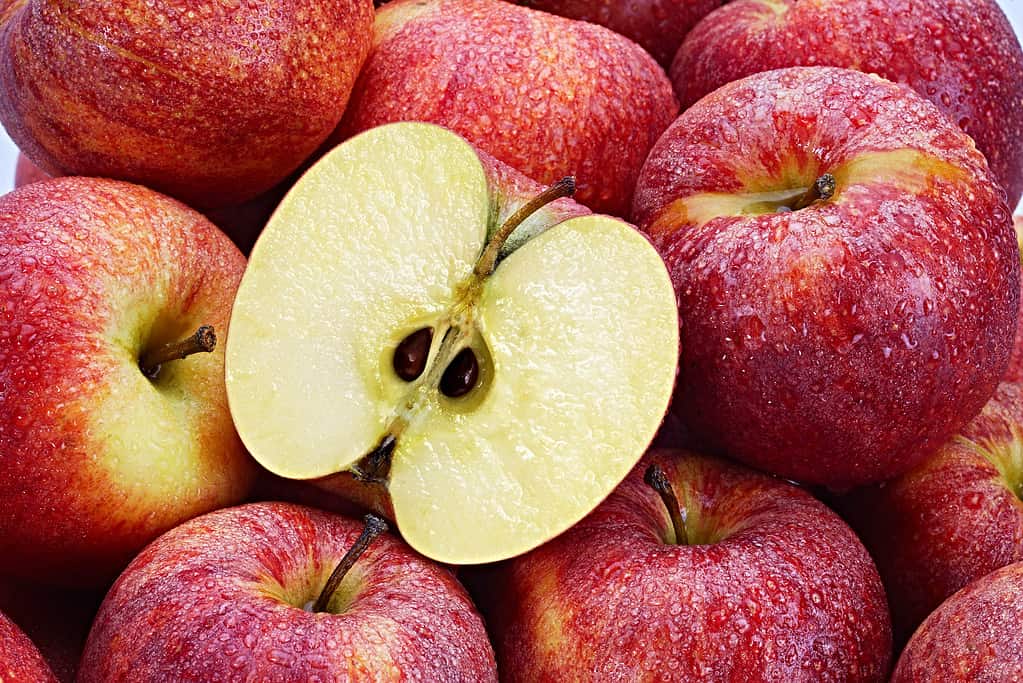
Seeds can be collected from ripe apples.
©hacohob/Shutterstock.com
Nurturing the Seed
- Water regularly: Keep the soil moist but not waterlogged. Water the seedlings regularly, especially during dry spells, to ensure that they have enough moisture to grow.
- Provide adequate light: Once the seedlings have emerged, make sure they receive adequate light. Place them in a location that receives at least six hours of sunlight per day or provide supplemental light if necessary.
- Fertilize: As the seedling grows, you can begin to fertilize it with a balanced fertilizer that is high in nitrogen. Follow the instructions on the fertilizer label for application rates.
- Transplant: Once the seedling has grown to about 8-10 inches (20-25 cm) tall, it can be transplanted to its permanent location. Choose a location that provides adequate space for the mature tree and follow the spacing requirements for the rootstock and variety.
- Prune: Once the tree is established, it will require pruning to maintain its shape and promote fruit production. Follow proper pruning techniques to ensure healthy growth and fruit production.
- Be patient: Growing an apple tree from a seed is a long-term project that requires patience. It can take several years for the tree to begin producing fruit, but the reward of harvesting your own home-grown apples can be well worth the wait.
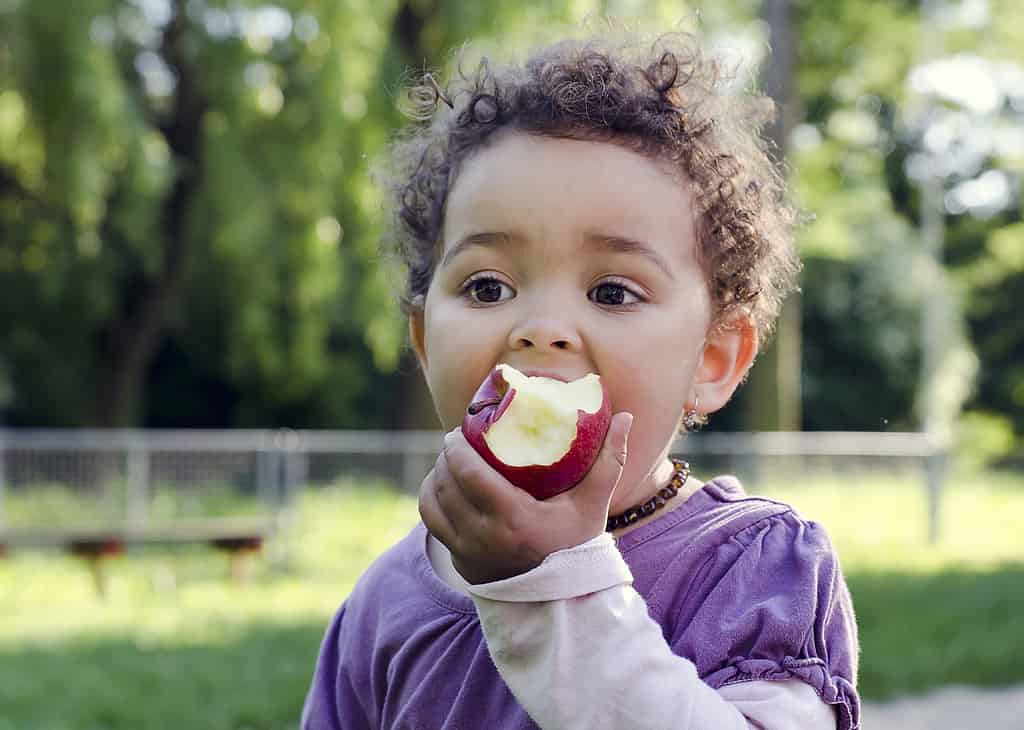
The reward of harvesting your own home-grown apples can be well worth the wait.
©pavla/Shutterstock.com
Five Fabulous Facts about Apples
- Apples are a member of the rose family, along with other fruits such as pears, peaches, plums, and cherries.
- Apple trees can live for over 100 years.
- The apple is one of the most widely cultivated and consumed fruits in the world, with China, the United States, and Turkey being the top producers.
- The seeds of an apple contain a small amount of cyanide, although the amount is not usually harmful unless consumed in very large quantities.
- Apple blossoms are not only beautiful, but they are also a source of nectar and pollen for honeybees, making them an important crop.
The photo featured at the top of this post is © Serhii Hrebeniuk/Shutterstock.com
Thank you for reading! Have some feedback for us? Contact the AZ Animals editorial team.






